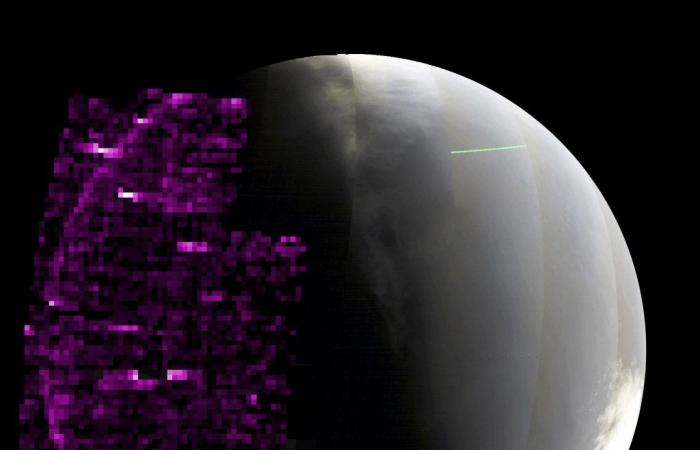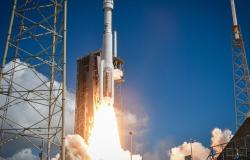A recent extreme solar storm provided valuable information about radiation exposure on Mars, crucial for future astronaut missions. The high-energy particles caused visual disruptions on Mars rovers and orbiters, while NASA’s MAVEN captured the resulting auroras. Credit: NASA/University of Colorado/LASP
In addition to producing stunning auroras, a recent extreme storm has provided more details about the amount of radiation future astronauts could encounter on the Red Planet.
NASARovers and orbiters have observed large solar flares and coronal mass ejections, with an X12 Solar eruption struck March on May 20. This event showed potential radiation doses for astronauts and caused visual disturbances on Mars equipment. Data from these observations will help plan radiation protection and future missions, including the upcoming ESCAPADE mission.
Extreme storms on Mars
Since the Sun entered a period of peak activity earlier this year, called solar maximum, Mars scientists have been anticipating epic solar storms. Over the past month, NASA’s Mars rovers and orbiters have provided researchers with front-row seats to a series of solar flares and coronal mass ejections that have reached Mars — in some cases even causing aurora Martians.
This scientific boon provided an unprecedented opportunity to study how such events play out in deep space, as well as the extent of radiation exposure the first astronauts might encounter on Mars.
The largest event occurred on May 20 with a solar flare later estimated to be a Class X12 solar flare — Class X solar flares are the most powerful of several types — according to spacecraft data space Solar Orbiter, a joint ESA mission (European Space Agency) and NASA. The flare sent X-rays and gamma rays toward the Red Planet, while a subsequent coronal mass ejection launched charged particles. Moving at the speed of light, the flare’s X-rays and gamma rays arrived first, while the charged particles trailed slightly behind, reaching Mars in just a few dozen minutes.
The spots in this scene were caused by charged particles from a solar storm hitting a camera aboard NASA’s Curiosity Mars rover. Curiosity uses its navigation cameras to try to capture images of dust swirls and gusts of wind, like the one seen here. Credit: NASA/JPL-Caltech
Radiation Exposure on Mars
The space weather development was closely monitored by analysts at the Moon-Mars Space Weather Analysis Office at NASA’s Goddard Space Flight Center in Greenbelt, Maryland, who reported the possibility of particle arrival charged following the coronal mass ejection.
If the astronauts had been standing next to NASA’s Curiosity Mars rover at the time, they would have received a radiation dose of 8,100 micrograys, the equivalent of 30 chest X-rays. While not life-threatening, it was the strongest surge measured by Curiosity’s Radiation Assessment Detector, or RAD, since the rover landed 12 years ago.
NASA’s Curiosity Mars rover captured black-and-white streaks and dots using one of its navigation cameras just as particles from a solar storm arrived on the Martian surface. These visual artifacts are caused by energetic particles hitting the camera’s image detector. Credit: NASA/JPL-Caltech
Planning for future missions
Data from RAD will help scientists plan for the highest level of radiation exposure astronauts might encounter, which they could use on the Martian landscape to protect themselves.
“Cliffs or lava tubes would provide additional protection to an astronaut against such an event. In Mars orbit or deep space, the dose rate would be significantly higher,” said RAD principal investigator Don Hassler of the Solar System Science and Exploration Division at the Southwest Research Institute in Boulder, Colorado. “I would not be surprised if this active region of the Sun continues to erupt, leading to even more solar storms on Earth and Mars in the coming weeks. »
Effects on Mars rovers and orbiters
During the May 20 event, so much energy from the storm hit the surface that black-and-white images from Curiosity’s navigation cameras danced with “snow” — white streaks and dots caused by charged particles hitting the cameras.
Similarly, the star camera used by NASA’s Mars Odyssey orbiter in 2001 for orientation was flooded with energy from solar particles and momentarily shut down. (Odyssey has other ways of orienting itself and recovered the camera within an hour.) Even with the brief time gap with its star camera, the orbiter collected vital data on X-rays, gamma rays and charged particles using its high-energy neutron. Detector.
This wasn’t the first time Odyssey had a brush with a solar flare: in 2003, solar particles from a solar flare, ultimately estimated to be an X45, fried Odyssey’s radiation detector, designed to measure such events.
The purple color in this animation shows auroras on the Mars night as detected by the Imaging Ultraviolet Spectrograph instrument aboard NASA’s MAVEN (Mars Atmosphere and Volatile EvolutioN) orbiter. The brighter the purple, the more auroras are present. Taken as waves of energetic particles from a solar storm were arriving on Mars, the sequence stops at the end, when the wave of the most energetic particles arrives and overwhelms the instrument with noise. MAVEN took these images between May 14 and 20, 2024, as the spacecraft orbited beneath Mars, looking at the night side of the planet (Mars’ south pole is visible on the right, in bright sunlight). Credit: NASA/University of Colorado/LASP
Auroras on Mars
Far above Curiosity, NASA The MAVEN (Mars Atmosphere and Volatile EvolutioN) orbiter captured another effect of recent solar activity: glowing auroras above the planet. The way these auroras occur is different from those seen on Earth.







